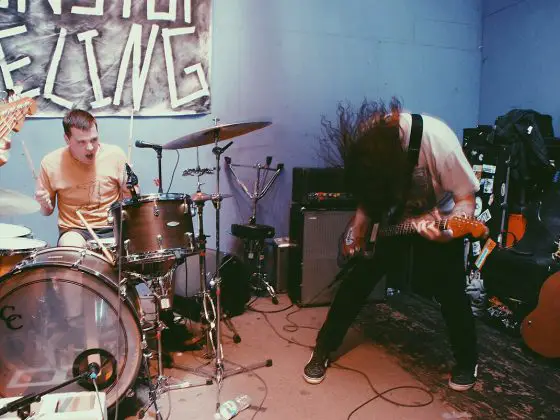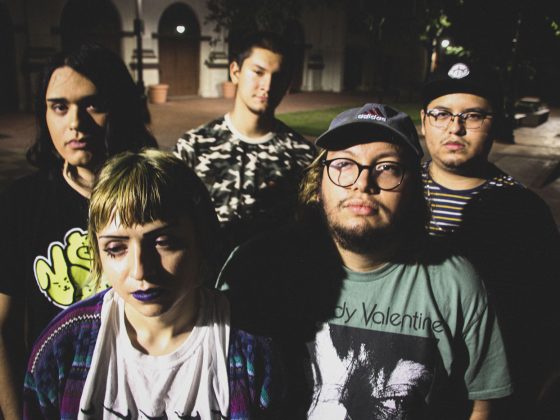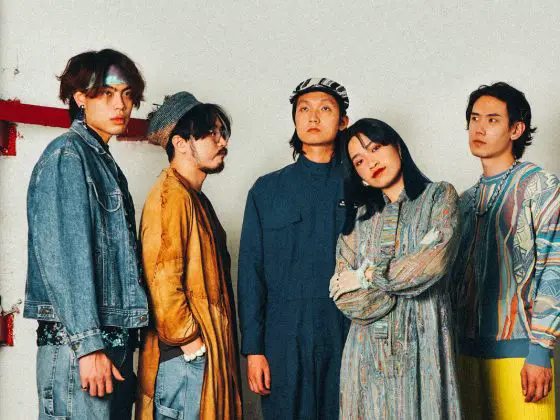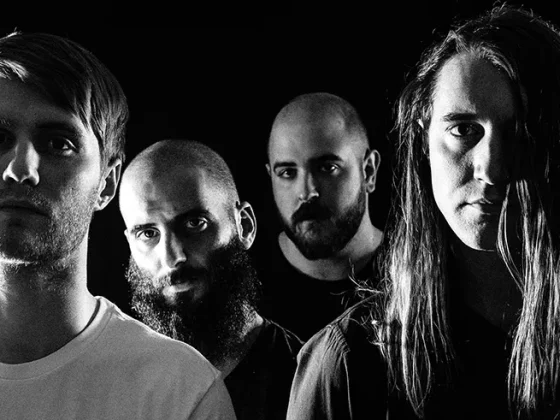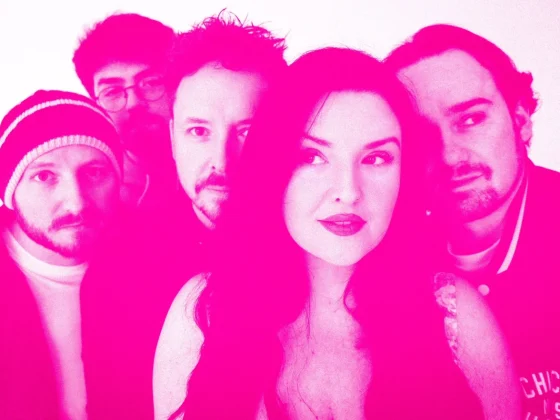In this exclusive excerpt from his book Whisper Aloud: Czech Shoegaze Between the East and the West, Miloš Hroch recalls the rise of the Czech band Here, who nearly took London by storm in the 1990s.
Photo: Here live in 1996, featuring Entre Deux Soleils. Zdeněk Marek (left) and Valerie Chauvey (right). Photo by Dagmar Dufková (Bauerová).
The origins of the band Here trace back to cousins Zdeněk Marek and Tomáš Luska, who formed the group in Vyškov na Moravě, a modest town in Czechia, located southeast of Prague. Known for its Socialist-era concrete housing estates and as a military hub, Vyškov was a tough environment for youth, especially during the Communist era. Luska’s life changed dramatically in 1990 after receiving a cassette from a friend, shortly after the Velvet Revolution. The tape contained music from France Inter’s Bernard Lenoir’s show, L’Inrockuptible. It was here that Luska first heard Nowhere by Ride, a pivotal moment that sparked his creative vision. Luska describes his reaction: “I listened to it in my bed, headphones on, staring at the ceiling, and nobody had any idea of what was happening inside my head.”
This overwhelming sense of discovery was something that resonated with many listeners of the shoegaze genre. Ride, much like other shoegaze bands, introduced a hypnotic, oceanic feel that Luska had never experienced. This influence became evident as they started their own band. The group, which consisted of cousins and local friends from their pub, included Zdeněk Marek on bass, Martin Pecka on drums, Pavel Koutný as a second bassist, and their first female vocalist Kateřina Crhonková. They called themselves Here and coined their own genre, flower noise. Their music was a blend of rugged feedback, dreamy soundscapes, and introspective lyrics. “Noise and shoegaze are for people with imagination,” said drummer Martin Pecka.
While Prague had already established a thriving indie scene with bands like Ecstasy of St. Theresa and Toyen, Here was an outsider from the Eastern part of Czechia. Their debut album Swirl, recorded in 1993 near Brno, perfectly encapsulated their unique sound. The album, produced by Colin Stuart, had an ethereal, layered quality. With melodies submerged under thick guitar noise, Swirl felt timeless, capturing a sense of uncertainty that permeated post-Velvet Revolution Czech society.
Despite their hazy, ambient sound, Here wasn’t overly concerned with fitting in. In interviews, they explained that their lyrics and music reflected the present, focusing on personal experiences rather than politics. The album blended elements of shoegaze with melancholic atmospheres, recalling the feeling of floating in memory or emotional haze, as exemplified by songs like “Haze” and “Flower Rain.” These tracks explored themes of confusion, emotional vulnerability, and existential reflection.
Despite their artistic accomplishments, Here’s path to success wasn’t smooth. Their music, especially in its early days, was often misunderstood. Swirl’s murky production left some listeners disappointed, with one father even returning the CD, claiming it sounded defective. The album’s fuzzy, layered sound, far from the bright, polished production common at the time, was a deliberate choice by the band and their British producer Colin Stuart. However, the album’s ambiguity worked to its advantage. It caught the ear of legendary BBC DJ John Peel, who aired multiple tracks, including “Scars in Days,” after receiving a copy of Swirl from a Czech friend.
In 1993, Here received an invitation from Peel to record a Peel Session in London. This unexpected opportunity marked the beginning of their unforgettable adventure in England. The band’s manager, Andrea Procházková, a Czech au-pair in London, played a crucial role in securing the London gigs. She became their connection to the city’s underground music scene, facilitating the logistics of their London debut. With Andrea’s help, they performed at iconic venues like the Bull & Gate and the Marquee Club, sleeping in squats, and surviving on minimal funds.
For Here, the reality of touring in London was sobering. Despite their initial excitement, the band realized that London’s live music scene was intensely competitive. Without the support of a team or a strong fan base, even the most talented bands could easily fade into obscurity. As Zdeněk Marek later reflected, “There are a hundred clubs, and you’re just another drop in the ocean.”
The band’s brief yet poignant English adventure culminated in a memorable Peel Session at the BBC, where they recorded with veteran engineer Mike Robinson. This experience was marked by technical difficulties, including the last-minute scramble to get UK-approved electrical plugs. Nevertheless, the session captured Here’s raw, unrefined energy, with fluid, impromptu arrangements and the inclusion of violin and piano.
In the years following their London stint, Here’s journey became a symbol of youthful rebellion, creativity, and the DIY spirit of the shoegaze movement. Their music, as elusive and dreamlike as the genre they pioneered, continues to resonate with listeners worldwide.



